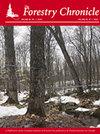黄桦针叶混交林部分采伐周期的预测
IF 0.8
4区 农林科学
Q3 FORESTRY
引用次数: 0
摘要
自20世纪90年代中期以来,部分砍伐已被广泛应用于黄桦针叶林(BJR, bsamtulaies jaunes)的温带森林。我们研究了剩余基础面积对林分组成的影响,以及根据曲海地区森林管理的通常标准,重建足够的可销售基础面积以允许第二次部分砍伐所需的时间。为此,我们使用了来自9个实验的数据集,以及对artsamis -2014增长模型和BJR新模型的模拟,我们使用研究数据对其进行了校准。结果表明,残基面积对林分年增量的影响最大,在砍伐后10 ~ 15年达到峰值。残基面积也影响砍伐周期的长度和未来的林分组成。我们估计,平均剩余基底面积为18 m2·ha -1时,平均采伐周期为24年,平均剩余基底面积为14 m2·ha -1时,平均采伐周期为40年。对于后者,我们的研究结果还表明,一些商业价值较低的机会性物种,如红枫,可能会变得更加丰富。本文章由计算机程序翻译,如有差异,请以英文原文为准。
Forecasting the partial cutting cycle for Québec yellow birch-conifer mixedwood stands
Since the mid 1990s, partial cuts have been widely used in yellow birch–conifer stands (BJR, bétulaies jaunes résineuses) in the temperate forests of Québec. We studied the impact of residual basal area on stand composition and on the time required to reconstitute enough merchantable basal area to allow for a second partial cut, according to the usual standards of forest management in Québec. To do so, we used a dataset from 9 experiments as well as simulations of the Artémis-2014 growth model and those of a new model, BJR, which we calibrated using the study data. Our results show that residual basal area influences stand periodic annual increment, which peaks 10 to 15 years after the cut. Residual basal area also influences the length of the cutting cycle and future stand composition. We estimated a mean cutting cycle of 24 years for a mean residual basal area of 18 m 2 ·ha -1 , and of 40 years for a mean residual basal area of 14 m 2 ·ha -1 . For the latter, our results also show that some opportunistic species of lesser commercial value, such as red maple, could become more abundant.
求助全文
通过发布文献求助,成功后即可免费获取论文全文。
去求助
来源期刊

Forestry Chronicle
农林科学-林学
CiteScore
1.20
自引率
0.00%
发文量
6
审稿时长
18-36 weeks
期刊介绍:
The Canadian Institute of Forestry has published The Forestry Chronicle, a professional and scientific forestry journal, since 1925. The Forestry Chronicle is published to provide information to forest practitioners about professional and scientific management of forests and their resources. The Forestry Chronicle provides forest practitioners in Canada and around the world with a means to communicate with their peers in the professional community.
 求助内容:
求助内容: 应助结果提醒方式:
应助结果提醒方式:


